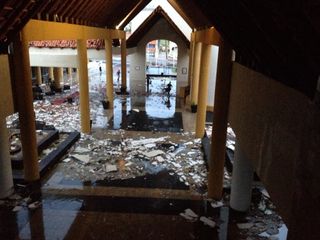Hurricane Odile Pounds Baja, Heads Toward US

Hurricane Odile hit the Mexican resort city of Cabo San Lucas Sunday night (Sept. 14), tying the record for the strongest hurricane ever recorded on the Baja Peninsula.
After briefly reaching category 4 strength, Hurricane Odile weakened before it slammed into Baja at 9:45 p.m. Pacific time (12:45 a.m. ET). The category 3 hurricane overturned cars, destroyed roofs and flooded beaches with its powerful storm surge. Sustained winds reached 125 mph (201 km/h), the fastest recorded in Baja since 1967's Hurricane Olivia. Government officials opened storm shelters for the thousands of people evacuated by authorities from low-lying coastal areas, and hotels transformed conference centers into safe rooms for guests. [Watch Hurricane Odile Hit Baja (Video)]
Monday morning, the fierce storm had faded to a category 2 hurricane, with 110 mph (177 km/h) winds. The storm is heading northwest at 14 mph (22 km/h) and will threaten central and coastal Baja with strong winds and heavy flooding through Wednesday, according to National Hurricane Center. By this weekend, the hurricane's remaining moisture could surge into Arizona, forecasters said. Phoenix suffered deadly flash flooding last week when the remnants of Hurricane Norbert passed over the city.
The last major hurricane to strike Baja was Hurricane Kiko, a category 3 storm that hit southern Baja near Punta Arena in 1989. Unlike Odile, Hurricane Kiko quickly tracked west and headed out to sea, causing relatively minor damage despite its ferocity.
One of Baja's worst natural disasters was Hurricane Liza in 1976, which killed more than 1,200 people, making the storm one of the deadliest Pacific hurricanes in history. The storm passed close to southern Baja but did not make landfall.
Both coasts of Mexico have been battered by hurricanes this season. Warmer-than-average waters in the eastern Pacific are fueling the frequent storms. The heat comes from a budding El Niño, a natural climate cycle in the Pacific Ocean that influences hurricane activity and global rainfall. Both 1976 and 1989 were El Niño years.
Email Becky Oskinor follow her @beckyoskin. Follow us @livescience, Facebook& Google+. Original article on Live Science.
Sign up for the Live Science daily newsletter now
Get the world’s most fascinating discoveries delivered straight to your inbox.

